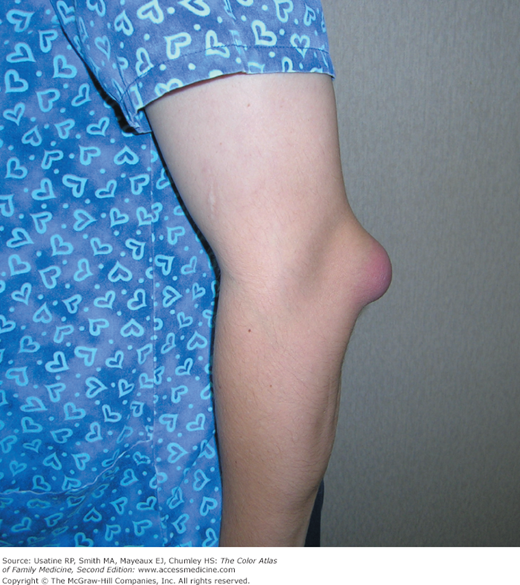Patient Story
A 60-year-old man presents with swelling in his elbow for the last 2 months. He does not have pain unless he leans on his elbow. He denies any trauma. Figure 101-1 demonstrates a “goose egg” swelling over the olecranon bursa that is not warm and is tender only to palpation. He has full range of motion. His olecranon bursitis was treated with ice, rest, and NSAIDs and he was told to avoid leaning on his elbow.
Introduction
Olecranon bursitis can be aseptic, from repetitive trauma or systemic disease, or septic, most commonly from Gram-positive bacteria. Differences in clinical presentation help differentiate aseptic from septic olecranon bursitis; however, analysis of fluid may be necessary. Aseptic olecranon bursitis is treated with an elbow pad, NSAIDs, and ice. Septic olecranon bursitis is treated with drainage and antibiotics.
Epidemiology
Prevalence of aseptic olecranon bursitis is unknown, but is estimated to be twice as common as septic olecranon bursitis.1
- Prevalence of septic olecranon bursitis is at least 10 per 100,000 in the general population.2
- Peak age of onset is 40 to 50 years.
- Eighty-one percent are male.
- Fifty percent have antecedent trauma.
Etiology and Pathophysiology
Risk Factors
Diagnosis
The diagnosis of olecranon bursitis is made clinically, by its typical appearance (Figures 101-1 and 101-2). When necessary, joint aspiration verifies the diagnosis and separates septic from aseptic bursitis.
Figure 101-2
Aseptic olecranon bursitis secondary to repetitive elbow leaning in this computer programmer. There is some erythema and minimal tenderness. The aspirated fluid was clear. Most patients (70%) retain full extension in the elbow despite swelling over the olecranon. (Courtesy of Richard P. Usatine, MD.)
- Common symptoms—Pain (87%), redness (77%), and subjective fever or chills (45%).
- Common signs—Erythema (92%), swelling (85%), edema (75%), tenderness (59%), and fluctuance (50%).
- Less common signs—Decreased range of motion (27%) and temperature greater than or equal to 37.8°C (100.04°F) (20%).
Stay updated, free articles. Join our Telegram channel

Full access? Get Clinical Tree




